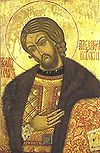- Vladimir Chelomey
-
Vladimir Nikolayevich Chelomey (Ukrainian: Володимир Миколайович Челомей; Russian: Влади́мир Никола́евич Челоме́й; June 30, 1914—December 8, 1984) was a Soviet mechanics scientist and rocket engineer from Ukraine.
Contents
Early life
Chelomey was born in Siedlce, Russian Empire (now Poland) into a Ukrainian family. At the age of three months, his family fled to Poltava, when World War I came close to Siedlce.
When Vladimir was twelve years old, the family moved again to Kiev.
In 1932, Chelomey was admitted to the Kiev Polytechnic Institute (later the basis of Kiev Aviation Institute), where he showed himself as a student with outstanding talent. In 1936, his first book Vector Analysis was published. Studying at the institute, Chelomey also attended lectures on mathematical analysis, theory of differential equations, mathematical physics, theory of elasticity, and mechanics in the Kiev University. He also attended lectures by Tullio Levi-Civita in the Ukrainian SSR Academy of Sciences. Namely in this time Chelomey became interested in mechanics and in the theory of oscillations and remained interested the rest of his life. In 1937, Chelomey graduated from the institute with honors. After that he worked there as a lecturer, defending a dissertation for the Candidate of Science (in 1939).
World War II
From the beginning of the Great Patriotic War, Chelomey worked at the Baranov Central Institute of Aviation Motor Building (TsIAM) in Moscow, where he created the first Soviet pulsating air jet engine in 1942, independently of similar contemporary developments in Nazi Germany.
In summer 1944, it became known that Nazi Germany used V-1 cruise missiles against Southern England. On October 19, 1944, following a decision by the USSR State Defense Committee and People's Commissar for Aviation Industry Alexey Shakhurin, Chelomey was appointed the Director and Chief Designer of Plant N51 (its previous director Nikolay Polikarpov having died a short time before). Chelomey was to design, build, and test the first Soviet cruise missile at the earliest possible date. As early as December 1944, the missile, code-named 10X, was test fired from Petlyakov Pe-8 and Tupolev Tu-2 aircraft.
OKB-52 and academic career
Following his success with the 10X, the USSR Special Design Bureau on designing pilot-less aircraft (OKB-52) was established under Chelomey's leadership. In 1955, Chelomey was appointed the Chief Designer of the OKB-52, where he continued to work on cruise missiles.
Chelomey continued his scientific research, earning a doctorate in science from Bauman Moscow Higher Technical School. After his dissertation defense in 1951, he became a professor at the School in 1952.
In 1958, OKB-52 put forward a proposal for a multi-stage Intercontinental ballistic missile. Although their UR-200 rocket design was rejected in favour of Mikhail Yangel's R-36 (NATO designation SS-9 Scarp), their UR-100 design was accepted.
Chelomey's OKB was part of the General Machine-Building Ministry headed by Sergey Afanasyev.
Spacecraft
In 1959, Chelomey was appointed the Chief Designer of Aviation Equipment.
OKB-52, along with designing ICBMs, started to work on spacecraft, and in 1961 began work on a design for a much more powerful ICBM, the UR-500.
In 1962, Chelomey became an Academician of the USSR Academy of Sciences, Mechanics Department.
Chelomey became Korolyov's internal competitor in the "Moon race". Chelomey proposed that the powerful UR-500 be used to launch a small two-man craft on a lunar flyby, and managed to gain support for his proposal by employing members of Khrushchev's family. He also claimed the UR-500 could be used to launch a military space station.
Following Khrushchev's removal, Chelomey's and Korolyov's projects were combined, but the Soviet Lunar program continued. The first launch of the UR-500 (also known as Proton) took place on March 10, 1967.
Although it was never used to send cosmonauts to the Moon as Chelomey had hoped, Proton has been widely used to launch Soviet satellites, as well as all Soviet/Russian space stations and modules including two of the first three components of the International Space Station (ISS).
The Earth satellites such as Polyot were also designed by Chelomey's OKB. Unlike earlier such craft, even Chelomey's first satellites Polyot-1 (1963) and Polyot-2 (1964) were able to change their orbits themselves. He also headed the development of the Proton satellite. In the 1970s Chelomey's OKB worked on the Almaz orbital stations Salyut 2, Salyut 3, and Salyut 5 which also became the basis for the Salyut, Mir, and Zvezda space stations. To support his Almaz stations, Chelomey designed the TKS, as an alternative to Soyuz. The TKS never flew as planned but derivatives flew as modules on Salyut 7 and Mir.
Chelomey died in Moscow in 1984.
Awards
- Two times Hero of Socialist Labor (1959, 1963)
- USSR State Prize (1967, 1974, 1982)
- Lenin Prize (1959)
- Four Orders of Lenin
- Order of the October Revolution
External links
- (Russian) Biography
People from Russia Leaders and religious - Pre-1168
- 1168–1917
- 1922–1991
- 1991–present
- RSFSR leaders
- General secretaries
- Soviet premiers (1st deputies)
- Soviet heads of state (and their spouses)
- Prime ministers (1st deputies)
- Foreign ministers
- Prosecutors general
- Metropolitans and patriarchs
- Saints

Military and explorers - Field marshals
- Soviet marshals
- Admirals
- Aviators
- Cosmonauts
Scientists and inventors - Aerospace engineers
- Astronomers and astrophysicists
- Biologists
- Chemists
- Earth scientists
- Electrical engineers
- IT developers
- Linguists and philologists
- Mathematicians
- Naval engineers
- Physicians and psychologists
- Physicists
- Weaponry makers
Artists and writers Sportspeople - Chess players
Categories:- Russian inventors
- Soviet space program personnel
- Soviet scientists
- Russian people of Ukrainian descent
- 1914 births
- 1984 deaths
- Burials at Novodevichy Cemetery
- Heroes of Socialist Labour
- Early spaceflight scientists
- Rocket scientists
- Ukrainian engineers
- Ukrainian scientists
- Ukrainian people of World War II
Wikimedia Foundation. 2010.


